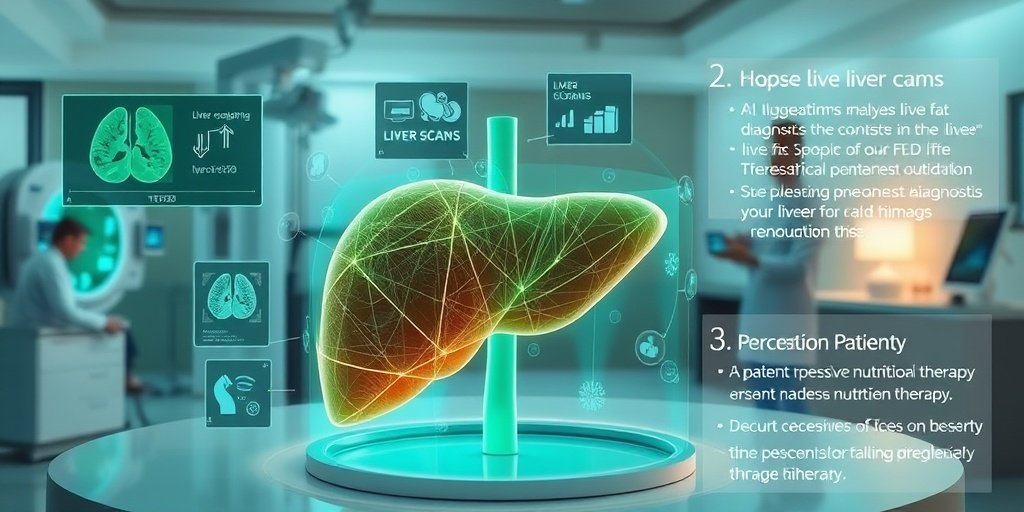⚡ Quick Summary
This study reviews the applications of artificial intelligence (AI) in the field of fatty liver disease (FLD), analyzing 270 articles published from 2006 to 2024. The findings highlight AI’s significant role in diagnosis, treatment, and prognosis of FLD, paving the way for advancements in precision medicine and telemedicine.
🔍 Key Details
- 📊 Dataset: 270 articles from the Web of Science Core Collection
- 🧩 Focus: Medical applications of AI in FLD
- ⚙️ Timeframe: 2006 to 2024
- 🏆 Key Areas: Diagnosis, therapy, prognosis, and drug development
🔑 Key Takeaways
- 📈 AI is primarily used for diagnosing FLD, evolving from basic tools to advanced classification methods.
- 💡 Integration of diverse data types has enhanced AI’s effectiveness in assessing liver fat content.
- 🧬 AI is being utilized in drug development and personalized nutritional therapies for FLD.
- 🔍 Researchers are increasingly exploring AI’s role in studying FLD-related genes.
- 🌐 AI has the potential to transform traditional medicine into more precise and resource-efficient practices.
- 📚 The study encourages future research in AI applications for FLD and related fields.

📚 Background
Fatty liver disease (FLD) is a growing health concern worldwide, often linked to obesity and metabolic syndrome. Traditional diagnostic methods can be limited in their accuracy and efficiency. The emergence of artificial intelligence offers a promising avenue for enhancing the prediction, diagnosis, and treatment of FLD, potentially leading to better patient outcomes and more personalized care.
🗒️ Study
This comprehensive analysis examined 270 articles published between 2006 and 2024, focusing on the medical applications of AI in FLD. The study aimed to identify trends and contributions from various authors, institutions, and countries, as well as to explore the evolving landscape of AI technologies in this field.
📈 Results
The findings revealed that AI is predominantly applied in the diagnosis of FLD, with a notable shift towards more sophisticated methods for classifying the disease and assessing liver fat content. The integration of diverse data sources, including imaging and clinical data, has significantly enhanced the capabilities of AI in this domain. Furthermore, AI’s role in drug development and personalized nutritional therapies is gaining traction, indicating a broader application of these technologies in managing FLD.
🌍 Impact and Implications
The implications of this study are profound. By leveraging AI, healthcare professionals can improve the accuracy and efficiency of FLD diagnosis and treatment. This shift not only enhances patient care but also conserves valuable healthcare resources. The potential for AI to facilitate advancements in precision medicine and telemedicine could lead to a more effective and personalized approach to managing FLD and related conditions.
🔮 Conclusion
This study underscores the transformative potential of AI in the realm of fatty liver disease. As AI technologies continue to evolve, they promise to revolutionize the way we approach diagnosis, treatment, and prognosis in FLD. Continued research and innovation in this field are essential for unlocking the full benefits of AI in healthcare, paving the way for a future where patient care is more precise and tailored to individual needs.
💬 Your comments
What are your thoughts on the integration of AI in managing fatty liver disease? We would love to hear your insights! 💬 Join the conversation in the comments below or connect with us on social media:
Trends in the applications of artificial intelligence in fatty liver diseases.
Abstract
INTRODUCTION: Artificial intelligence (AI) has rapidly advanced and shows great potential in the prediction, diagnosis, treatment, and prognosis of fatty liver disease (FLD). This study aims to summarize AI’s applications and emerging trends in FLD to inspire future research directions.
METHOD: We analyzed 270 articles sourced from the Web of Science Core Collection published between 2006 and 2024. The study focuses on the medical application of AI in FLD, examining the contributions of authors, institutions, countries, keywords, and cited references.
RESULTS: AI is predominantly applied in FLD diagnosis, with progression from simple diagnostic tools to advanced methods for classifying FLD and assessing liver fat content. Moreover, the types of data used in AI development have evolved, incorporating a variety of new image and clinical data sources. AI is also being integrated into drug development and personalized nutritional therapies for FLD. Additionally, researchers are becoming increasingly interested in the application of AI to study FLD genes.
CONCLUSION: We found that the applications of AI in FLD are mainly reflected in the prediction, diagnosis, therapy, and prognosis of FLD. In contrast to traditional medicine, AI has the potential to advance the fields of precision medicine and telemedicine, as well as to conserve additional social resources. Moreover, AI may help medical personnel from the perspective of traditional Chinese medicine, FLD prognosis, and the use of AI to analyze gene prediction and natural language processing (NLP).
Author: [‘Xie TA’, ‘Liufu LL’, ‘Chen HJ’, ‘Chen HL’, ‘Hou XT’, ‘Wang XR’, ‘Han MY’, ‘Shan YK’, ‘Shen RJ’, ‘Wu ZY’, ‘Li SJ’, ‘Juengpanich S’, ‘Topatana W’]
Journal: Hepatol Int
Citation: Xie TA, et al. Trends in the applications of artificial intelligence in fatty liver diseases. Trends in the applications of artificial intelligence in fatty liver diseases. 2025; (unknown volume):(unknown pages). doi: 10.1007/s12072-025-10827-1